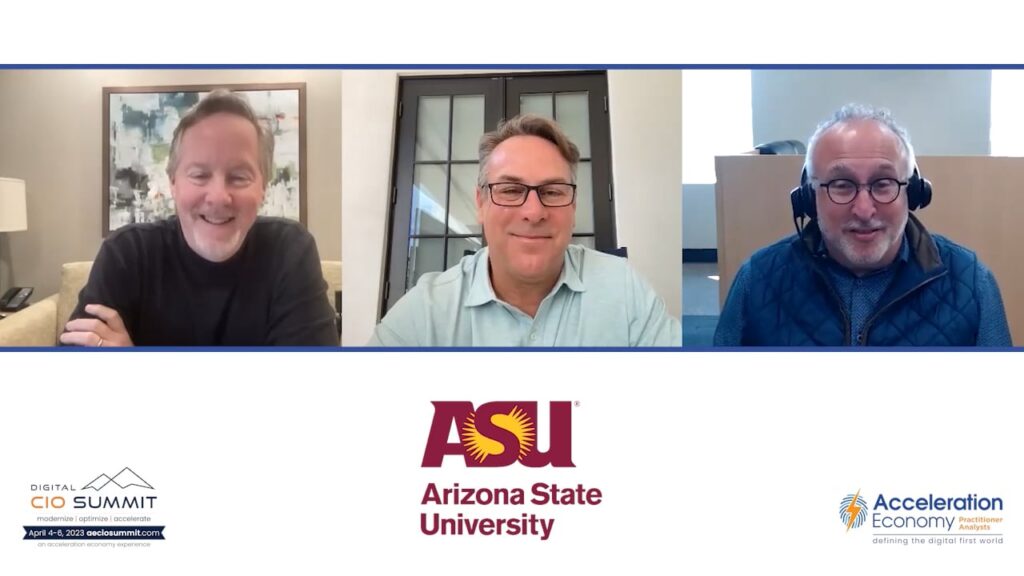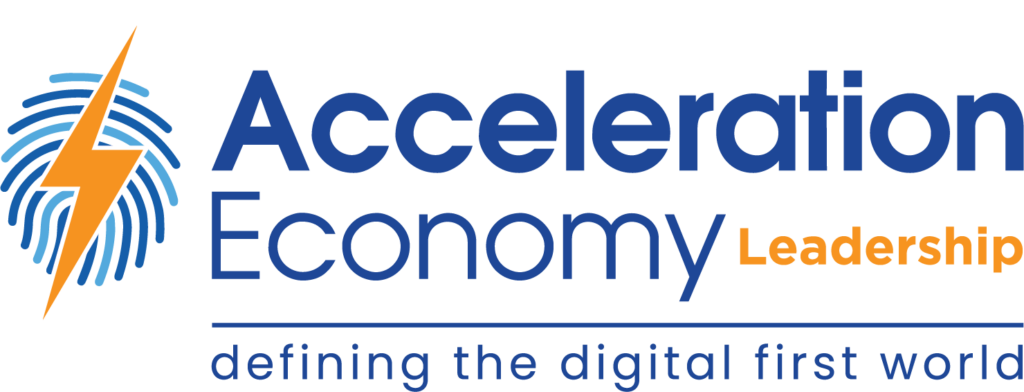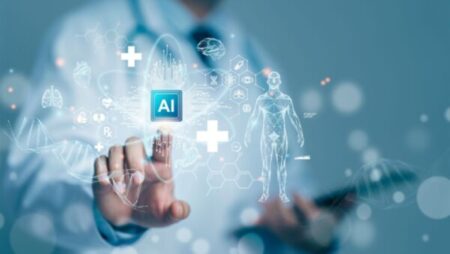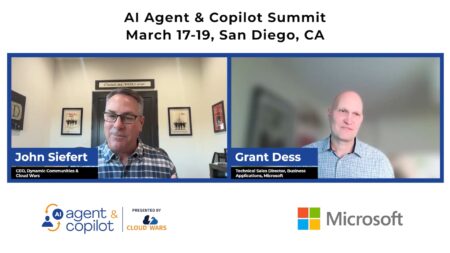Opening Roundtable Highlights
The flag was raised as Day 1 of the Acceleration Economy Digital CIO Summit kicked off with first-person, practitioner-led discussions with Bob Evans, Co-Founder of Acceleration Economy; Tony Uphoff, 4x CEO, Acceleration Economy Practitioner Analyst, and host of the Leadership Channel; Chris Hughes, CISO, Co-Founder of Aquia, and Acceleration Economy Practitioner Analyst; Joanna Martinez, Chief Procurement Officer, Founder of Supply Chain Advisors, and Acceleration Economy Practitioner Analyst; and Sheri Rhodes, Chief Customer Officer of Workday.
The discussion quickly dove into the importance of the role of the chief information officer (CIO), or rather the Office of the CIO, and, according to Tony Uphoff, how they need to “design their systems and infrastructure of technology from the customer into the company as opposed to internal systems out to the customer.”
Joanna Martinez built on Tony’s insights. “From my standpoint, as a CPO [chief procurement officer], what did I do all day? I was a customer, and those companies where there was visionary leadership, where they were really looking at the customer experience, made a huge difference.”
As a former CIO, Workday’s Sheri Rhodes had a unique take on how CIOs should be more responsive toward customers. “I think it starts with collaboration,” said Sheri. “Understanding how the end-to-end process works across the business means you need to bring all the stakeholders together.
“Then, really, it’s agility and a bias for action. If we’re not executing against the roadmaps, and we’re not making change, and we’re not doing that in an iterative, constant way, then the business can get stale.”
With his chief information security officer (CISO) point of view, Chris Hughes hit the nail on the head. “What stood out to me right away is how the CIO has shifted from being internal to external facing with the customer.” This means that the CIO needs to shift their mindset on how the business operates, and, according to Chris, “Everyone’s come to realize that you are a software company that happens to do X.”
This discussion set the stage for the rest of the event as cybersecurity, multi-cloud, innovation, artificial intelligence, infrastructure, higher education, and dazzling customers each took the spotlight.
How FedEx Modernized Its Business Models to Dazzle Customers
“Dominant design” permeated the conversation as the CIO of FedEx, Rob Carter, joined Bob Evans, Founder of Cloud Wars. Carter put the concept into context not only from a historical perspective of re-architecting cities but also from a modern business perspective of re-architecting technology.
“If we’ve got this ‘accidental architecture’ that’s occurred over time as we’ve collected the artifacts of systems of the past and acquisitions. It’s heavy lifting to say, ‘No. We’re going to change that, but it’s too risky to stay where you are. You have to move forward into that bold and beautiful future.”
Bob summarized Rob’s take on this by saying, “It gets very messy and tough. There’s a lot of people that say, ‘Hey, wait a minute. Why are you messing up this thing that I’ve worked so hard to build?’ So, you have to be part psychologist, but keep people focusing on the bigger thing. Right?”
Rob continued, “Business partners in technology love to complain about the current technology. They love to complain about the legacy technology, but, at the same time, they’re clutching it.” He added, “Putting something new in is hard until you look back on it.”
He then challenged the cliched term of “If it ain’t broke, don’t fix it” by stating, “In the modern world, it is broke. You just haven’t noticed it yet.”
This brought the conversation to “dominant design.” To set the tone, Rob called old technology things we have “embedded in the Museum of Technology that lives in our data centers.” And “the odds of [people] using them is zero.”
He continued, “The interesting thing about dominant design is that it’s actually an engineering term that doesn’t get used very often.” Rob then shared the example of the electrical plug on the wall. It didn’t always look that way, but today we have a standard of a 110 or 220 outlet depending on where you live.
“Tesla and Edison were duking it out in the U.S. over AC and DC, and ultimately, Tesla won with the notion of a 110 alternating current versus direct current.” According to Rob, swapping out old legacy technology as electrification began was a hard battle.
Rob challenged traditional thinking regarding innovation and invention as many tend to use these terms interchangeably. “Innovation is different than invention. Innovation is always taking piece parts and putting them together in unique ways to create new value.”
Building on that concept, Rob put his first-person perspective forward, “As we sit here, we’re in the very twilight hours of any mainframe capacity left in the company.” He continued, “We have retired about 97% of the MIPS that once ran the business and moved all that technology onto modern frameworks.”
The discussion ended with Rob’s experiential knowledge. “Be great stewards of those systems and information because all of the good that they do, all the good that we experience in our lives with them, is also represented by inherent risk. And be ever vigilant in how you manage these technologies in a way that keeps your company and your customers safe.”
Operationalizing AI With Workday
My conversation with Shane Luke, VP of Product and Engineering, Head of AI & Machine Learning, was fascinating as we discussed something that I’m passionate about: ethical artificial intelligence (AI) and turning that into actionable outcomes.
“We have this singular data model that we’ve enforced throughout the whole history of Workday.” This approach put Workday in a unique position as it was building out the strategy to operationalize and deploy AI and machine learning (ML) at scale. “We wanted to leverage that [singular data model] strength as it offers us a few things that are difficult for other companies to be able to do.”
Interestingly, Shane shared something that Workday recently deployed, which is a globally distributed training model where the training is done “in region” alongside where the core tenant runs. “The cool thing about federated learning is that we don’t do that at the expense of the benefits of the global models.”
This federated AI learning allows Workday to aggregate what was learned and redeploy that to various global regions and industries.
Another area where Workday is using this federated learning is to help its customers understand the new skill sets and skills gaps that have emerged from new technology such as generative AI (think, ChatGPT) and machine learning.
Shane dug into this further to address the fear, uncertainty, and doubt swirling around AI replacing people. “We use assisted intelligence or augmented intelligence versus article intelligence. The computer doesn’t take over everything but does a much faster job for you.”
As an example, “If you are a big company, you might have 10 billion lines in your general ledger in a Workday financial product. 10 billion is not a human-scale number, but a bot can crawl 10 billion ledger lines to find anomalies.”
This approach puts a phrase that I use a lot into sharp context and helped cap the discussion. “It’s People + Technology, but People is in the front on purpose.”
Innovation and the Future of Higher Education
In the next segment, Lev Gonick, CIO of Arizona State University (ASU) chatted with Acceleration Economy Co-Founders John Siefert and Bob Evans on the hands-on innovation happening and how this turned into the “gold standard” for many other institutions.
“It’s the commitment of ASU and our Charter to support students and their learning journey.” This commitment is something that Lev was humbled, but proud, to share as “ASU has earned its technology innovation credentials.”
The astounding thing that Lev shared was the long journey that ASU took to get where they are today. “We were first to market with a large engagement in online education, now 14 years ago with 400 students enrolled. Fast forward to today, and we’re north of 70,000 students pursuing almost 250 degrees.”
Another aspect of this technology journey is that it’s not just for the students, but for ASU to continue its innovation. “We’re using a ton of creative adaptive technology. We’re engaged in virtual reality, working on generative AI, involved in blockchain technology, and dozens of other kinds of technology all in the service of Student Success.”
By building on this innovative foundation, Lev is leading the digital-first thinking and success that is a model for other CIOs. “Through CIO’s own experience and perhaps the organizational environments that they’re in, they have a deficit or scarcity mindset where you’re managing against all kinds of constraints.”
“That’s kind of a worldview. It’s not the view of ASU.”
To showcase this point, Lev outlined the unique ways that they are using generative AI to help students in their learning efforts. They are using this “as essentially a guide, a coach, to help students to really understand choices in the way that write.”
The coaching mindset doesn’t stop there as Lev closed out the discussion on the mindset that he speaks about a lot with CIOs and Boards all over the country. It boils down to how ASU has an intentional focus on Culture and Leadership principles. He then challenged organizations to ask if their culture is “explicit” to where anyone in the organization can articulate its leadership and value.
How the Human Side of AI Is Delivering Modern Business Outcomes
Just as Lev Gonick and Shane Luke put AI into the context of augmenting humans, John Granger, SVP of IBM Consulting, took that further with how they are accomplishing this at IBM.
However, before Granger dove into that, he shared his thoughts on generative AI. “I think as much as anything this whole ChatGPT thing is just a massive inflection point in terms of an ‘awakening,’ if you like, for clients and the business community of the real power of AI.”
To drive this point home, Granger provided an example of a large train company in Australia that receives about 30 million messages an hour from all different sources. By using AI, this company has seen a 51% increase in reliability.
He continued with a few other examples, such as:
- How they use AI to help customer support with better ticket responses.
- For security, summarizing event logs to recap incidents.
- Analyzing nearly 30,000 internal audit processes for a large bank across 5,000 controls.
Each of these successful examples was built on three core principles that IBM has put in place to govern data in the context of AI.
- AI and automation, and the results from those, are meant to augment human beings, not replace them.
- Demonstrate that the application of AI is fair and does not result in discrimination.
- Who is the owner of the data.
Granger closed out the conversation with something that he believes is a benefit to IBM clients in that they have a deep understanding of the enterprise. This understanding extends to the clients running mission-critical operations across multiple industries and geographies and underscores the first-hand knowledge of helping customers address pressing challenges.
AI, Cybersecurity, and Innovation in the Public Sector
Much of the event to this point had a primary focus on organizations in the private sector, with some alluding to the public sector. But Tony Uphoff’s discussion with Maria Roat, Former Federal Deputy CIO, showcased the amazing things that the government is doing with technology that often goes unnoticed.
Maria brought up a topic that Rob Carter of FedEx spoke about — innovation. Maria framed it like this, “Innovation is really foundational. Innovation is doing things differently. It’s a cultural shift to get people to think about doing things different, not the same old way.”
This thinking opens up teams to own the processes and execute the “how” of a strategy. Further, this allows people to have missteps, and make mistakes, as they figure things out. Maria shared that a mistake actually took down a network because they did one thing but didn’t realize what some of the old architecture did.
Additionally, the innovation mindset fostered a program that Maria lead called an Open House. This provided the opportunity for the staff to showcase creative things with data and new technologies, realizing that there is an element of risk.
However, Maria recognized the responsibilities of the CIO extend beyond being “just a technologist.” This has to be balanced with enforcing policies, cybersecurity, and the business role of governance which in turn translates into “making the technology work and enable the mission of the organization.”
The importance of the CIO role was, again, emphasized as Maria ended the discussion. Meaning that CIOS must be a business leader, understand the scope of the business, and know geospatial data . . . and, and, and.
The Good, Bad, and Ugly of Digital Transformation with Gorilla Glue
The final interview that took place was with Cedric Wells, Director of IT Infrastructure Services for Gorilla Glue, and Wayne Sadin, CDO/CIO/CTO and host of the Acceleration Economy Data Modernization channel.
Yes, Gorilla Glue is a very familiar brand and has very recognizable commercials to accompany the amazing products. Cedric shared a bit about the company, culture, and challenges that came along as they started their digital transformation process.
Something that Cedric addressed early on was getting an understanding of the business and how technology was being used. He then presented his findings and thoughts to the C-suite using the analogy of a concert. “You have these people that show up early to make sure that the stage was set up, all the instruments were out, and then they would go behind the scenes.”
“No one goes to a concert to hear the artist, right? You can just listen to Spotify. But it’s the lights, the feeling of the bass in your chest, the overall experience that people see – and technology enhances that.”
Cedric’s position in his C-suite presentation was, “Yes, we are a manufacturing company, but technology can do so much more.”
Building on the culture that Cedric alluded to earlier, he had the opportunity, along with his IT leader, to share a portfolio review with the management team. This allowed Cedric to educate everyone on the role of infrastructure as he was posed with this question — “I get the app stuff. I get security and the service desk, but the infrastructure stuff is so complex.”
Ceric took this as a positive to not only educate but a way to say, “Let’s go!” Meaning, let’s get moving on the digital transformation, let’s get moving on making technology the star.
To accomplish this, it meant that they needed to migrate to a different enterprise resource planning (ERP) solution — Oracle — and also leverage newer data capabilities by using Snowflake. Additionally, Cedric’s team had to ensure everything was running smoothly, and securely.
But this process was not accomplished in a vacuum. Cedric closed the conversation with a few key takeaways such as:
- Picking the right partners (notice the plural)
- Having a great team
- Adopting organization change management
- Culture
- Adjusting to doing things differently
His final advice was this, “For any company looking start, you’re probably a little bit behind. So, you need to get started on that journey, now – but don’t forget the people aspect.”
Closing Thoughts
This was a jam-packed day of insights, first-person perspectives, and practitioner-led sessions. I emphasize the word “practitioner” here as each of the segments today underscored that word in multiple ways. Practitioner means that you’ve rolled up your sleeves, navigated the hard stuff, led people through change, cheered on others, adapted, and adopted new technology, all the while putting people first.
No pie-in-the-sky, academic organization can come close to what Acceleration Economy Practitioner Analyst brings — and what the Digital CIO Summit did on Day 1 and will continue through Days 2 and 3.
To hear more data modernization, AI/hyperautomation, cybersecurity, and growth strategies from CIO practitioners, tune into Acceleration Economy’s Digital CIO Summit, which takes place April 4-6. Register for the free event here.







